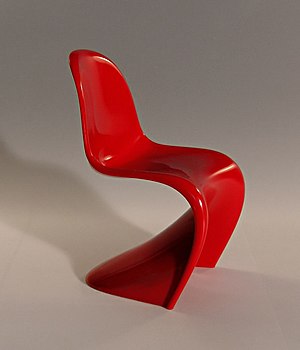Panton Chair
Panton Chair is an iconic piece of furniture in the history of modern design. Created by Danish designer Verner Panton in the 1960s, the chair is renowned for its unique and futuristic shape. It was the first chair to be manufactured completely out of plastic in a single piece. With its smooth, flowing lines and bold silhouette, the Panton Chair has become a symbol of mid-century modern design.
History[edit | edit source]
The Panton Chair was developed by Verner Panton in collaboration with the Vitra company, a leading manufacturer of designer furniture. Panton's vision was to create a chair that was comfortable, functional, and innovative in its use of materials and form. After several years of development, the chair was finally released to the public in 1967. Its introduction marked a significant moment in furniture design, showcasing the possibilities of plastic as a material and paving the way for future innovations in furniture manufacturing.
Design[edit | edit source]
The design of the Panton Chair is characterized by its S-shaped curve, which is ergonomic and allows for various sitting positions. The chair is made from a single piece of molded plastic, which gives it a sleek and seamless appearance. The absence of legs and traditional support structures was revolutionary at the time of its creation, demonstrating Panton's commitment to exploring new forms and technologies.
The Panton Chair is available in a variety of colors, which adds to its appeal and versatility as a design object. It can be used in a wide range of settings, from domestic interiors to public spaces, and it has been featured in numerous design exhibitions and museum collections around the world.
Impact[edit | edit source]
The Panton Chair has had a profound impact on the field of design. It is celebrated not only for its aesthetic qualities but also for its innovative use of materials and manufacturing techniques. The chair has inspired countless designers and has paved the way for the use of plastic in other furniture designs.
In recognition of its significance, the Panton Chair has received numerous design awards and is considered a classic of modern furniture design. It continues to be produced and sold by Vitra, and it remains popular with collectors and design enthusiasts.
Legacy[edit | edit source]
The legacy of the Panton Chair extends beyond its physical form. It represents a bold step in the evolution of furniture design, challenging traditional notions of what furniture could be. The chair's success has made Verner Panton a central figure in the history of design, and his work continues to influence designers today.
The Panton Chair is more than just a piece of furniture; it is a statement about creativity, innovation, and the endless possibilities of design. Its enduring popularity attests to its timeless appeal and its place in the pantheon of design classics.
Search WikiMD
Ad.Tired of being Overweight? Try W8MD's physician weight loss program.
Semaglutide (Ozempic / Wegovy and Tirzepatide (Mounjaro / Zepbound) available.
Advertise on WikiMD
|
WikiMD's Wellness Encyclopedia |
| Let Food Be Thy Medicine Medicine Thy Food - Hippocrates |
Translate this page: - East Asian
中文,
日本,
한국어,
South Asian
हिन्दी,
தமிழ்,
తెలుగు,
Urdu,
ಕನ್ನಡ,
Southeast Asian
Indonesian,
Vietnamese,
Thai,
မြန်မာဘာသာ,
বাংলা
European
español,
Deutsch,
français,
Greek,
português do Brasil,
polski,
română,
русский,
Nederlands,
norsk,
svenska,
suomi,
Italian
Middle Eastern & African
عربى,
Turkish,
Persian,
Hebrew,
Afrikaans,
isiZulu,
Kiswahili,
Other
Bulgarian,
Hungarian,
Czech,
Swedish,
മലയാളം,
मराठी,
ਪੰਜਾਬੀ,
ગુજરાતી,
Portuguese,
Ukrainian
Medical Disclaimer: WikiMD is not a substitute for professional medical advice. The information on WikiMD is provided as an information resource only, may be incorrect, outdated or misleading, and is not to be used or relied on for any diagnostic or treatment purposes. Please consult your health care provider before making any healthcare decisions or for guidance about a specific medical condition. WikiMD expressly disclaims responsibility, and shall have no liability, for any damages, loss, injury, or liability whatsoever suffered as a result of your reliance on the information contained in this site. By visiting this site you agree to the foregoing terms and conditions, which may from time to time be changed or supplemented by WikiMD. If you do not agree to the foregoing terms and conditions, you should not enter or use this site. See full disclaimer.
Credits:Most images are courtesy of Wikimedia commons, and templates Wikipedia, licensed under CC BY SA or similar.
Contributors: Prab R. Tumpati, MD

